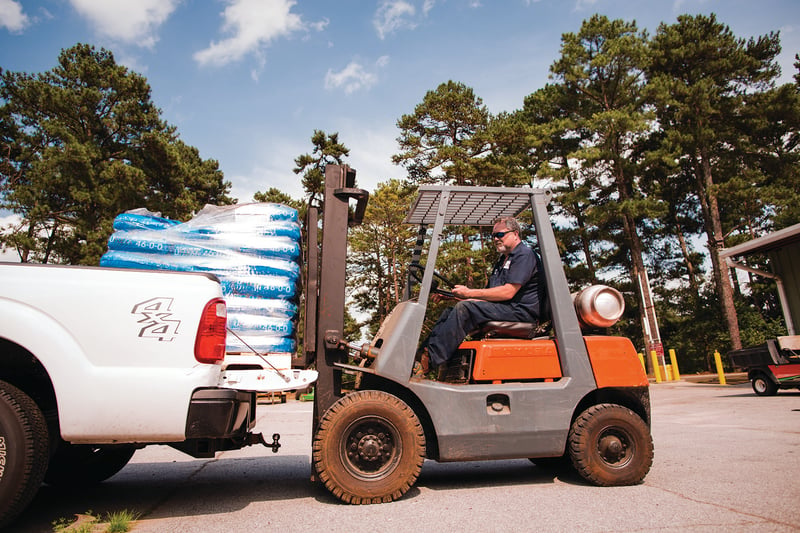
It’s up to you to Train, Evaluate Forklift Drivers
Forklift Safety: Driver training is up to the employer and knowing what OSHA requires can make you workplace safer and reduce the potential for fines or other problems
Driver training is up to the employer and knowing what OSHA requires can make you workplace safer and reduce the potential for fines or other problems.
Did you know that OSHA requires employers to provide forklift operator safety training before a worker takes on their first assignment? Do you know what this training should cover?
Employees who may operate a forklift must be trained according to OSHA Standard 1910.178. The standard requires employers to develop and implement a training program based on the general principles of safe forklift operation, the types of vehicle(s) being used in the workplace, the hazards of the workplace created by the use of the vehicle(s), and the general safety requirements of the OSHA standard. Trained operators must know how to do their job and operate the forklift properly, and they have to do it safely as demonstrated by a workplace evaluation.
The following information is based on OSHA’s ‘Frequently Asked Questions about Powered Industrial Truck Operator Training.’ It is available at www.osha.gov/dte/library/pit/pit_q-a.html
Formal training may include lectures and video instruction while practical training may include demonstrations and actual exercises with the forklift. Both types of instruction have to be provided to employees.
The employer must evaluate an employee’s performance and determine if he is competent to operate a forklift safely before the worker may begin operating a forklift. Refresher training is needed whenever an employee demonstrates he is not operating a forklift safely.
Employers must certify that each operator has received training and evaluate each operator at least once every three years.
OSHA provides a list of topics to be included in a forklift safety training program. However, an employer may exclude topics if they are not relevant to the safe forklift operation at the work site.
Training and evaluation must be conducted by persons who have the necessary knowledge, training, and experience to train forklift operators and evaluate their competence. An example of a qualified trainer would be a person who has a recognized degree, certificate or professional standing, or who has extensive knowledge, training, and experience and has demonstrated the ability to train and evaluate forklift operators.
An employer does not have to perform the training. Many training resources are available. These include forklift manufacturers, safety and health organizations, such as local chapters of the National Safety Council, technical and vocational schools, and private consultants.
In addition, there are various Internet sites devoted to forklift safety. Private companies that provide forklift safety training services, including videos and written programs, can be located on various Internet websites. Most videos can be leased or purchased.
An important thing to remember is that simply by showing employees a video or videos on some aspect of forklift safety does not meet the full requirements of the OSHA standard. Site specific information must be conveyed as well as a method to evaluate employees after their training.
What if you use a private consultant or some other source to provide your training? How do you know if your employees in fact have been adequately trained?
Consultants and safety or training organizations may provide evidence that an employee successfully completed classroom and practical training. However, the employer still is responsible to ensure that each forklift operator is competent to operate a truck safely — as demonstrated by the successful completion of training and an evaluation.
The OSHA standard does not specifically require testing, although some evaluation method is necessary.
OSHA requires the employer to certify that each operator has received training and has been evaluated. The written certification record must include the name of the operator, the date of the training, the date of the evaluation, and the identity of the person(s) who performed the training or evaluation.
Each forklift driver must be evaluated for their performance after their initial training, after refresher training, and at least once every three years.
Refresher training must be provided when:
- The employee has been observed to operate the forklift in an unsafe manner.
- The operator has been involved in an accident or near-miss incident.
- The employee has received an evaluation that reveals that he is not operating the forklift safely.
- The employee is assigned to drive a different type of forklift.
- A condition in the workplace changes in a manner that could affect safe operation of the forklift.
What if an employee already has received forklift training or has been operating forklifts for many years? Does the employer have to train them again? The short answer is no. An employer does not need to retrain someone if the employer certifies that the operator has been evaluated and has proven to be competent to operate the forklift safely. The operator would need additional training in areas where his performance indicates the need for further training and for new types of equipment and areas of operation.
There are various ways to evaluate if an employee can operate a forklift safely. These include written documentation of previous training, an interview or discussion with the employee, observing the employee operating the forklift, and a performance test.
For more information about forklift operator safety training, you can contact your local or regional OSHA office or visit the OSHA home page on the Internet: www.osha.gov/. Also, more information about training materials for forklifts and other resources are available at https://www.osha.gov/dte/library/materials_library.html#poweredindustrialtrucks.









